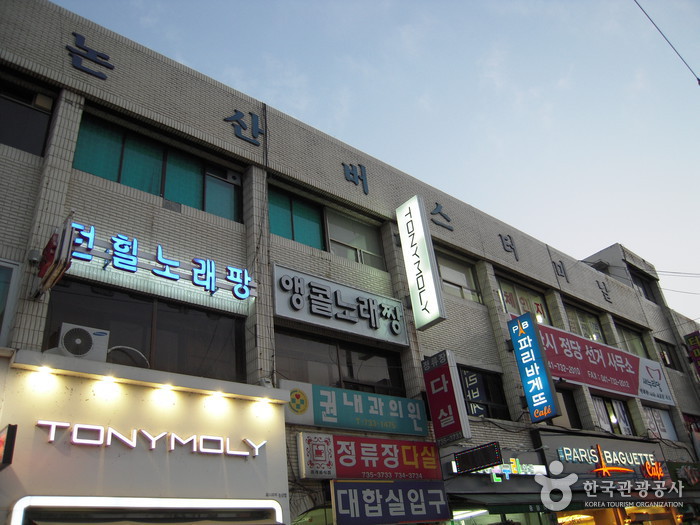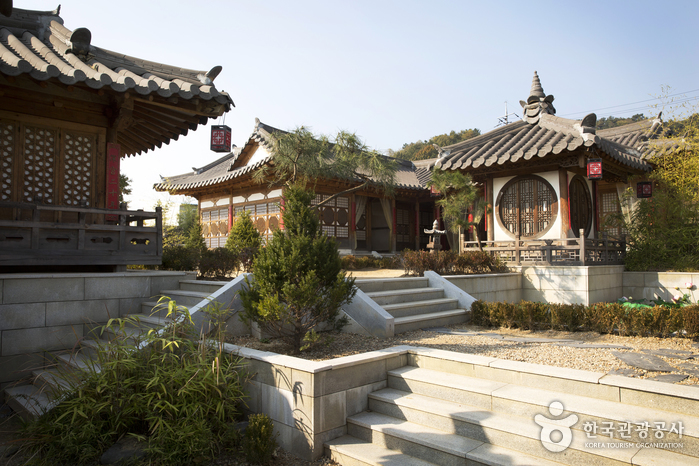Marché au poisson salé traditionnel de Ganggyeong (강경젓갈시장)
18.4Km 2021-03-29
30-3, Ongnyeobong-ro 27beon-gil, Nonsan-si, Chungcheongnam-do
Le marché au poisson salé traditionnel de Ganggyeong est un marché absolument unique où les poissonniers salent le poisson à la manière traditionnelle et excellent à choisir de bons produits. Par conséquent, les meilleurs poissons salés se trouvent au marché au poisson salé traditionnel de Ganggyeong.
Autour de Yeomcheolri les marchands vendent des crevettes salées et du poisson à tout le pays. Les crevettes salées représentent la moitié du marché global de Corée. Le marché au poisson salé traditionnel de Ganggyeong est très fréquenté de la mi-juin jusqu’à la fin novembre juste avant la saison du kimchi d’hiver. A cette époque de l’année, il se remplit de commerçants, de marchands et de ménagères souhaitant acheter du poisson salé à bas prix. Du début du mois d’août au début du mois de décembre, près de 250 tonneaux de poissons sont vendus. Le marché au poisson salé traditionnel de Ganggyeong organise encore un festival chaque année.
- Les crevettes salées
La taille des crevettes importe peu mais les crevettes à la peau fine et blanche sont meilleures. Les meilleures crevettes salées ont une teinte légèrement rouge.
- Les anchois salés
Les bons anchois salés sont rougeâtres et ont une odeur sucrée. Les meilleurs anchois sont pêchés à Chujado, une île près de Jeju-do, en août.
Festival des produits de la mer en saumure de Ganggyeong (논산 강경젓갈축제)
18.5Km 2022-09-22
45, Geumbaek-ro, Nonsan-si, Chungcheongnam-do
- Ligne Info Tourisme : +82-41-1330 (coréen, anglais, japonais, chinois) - Pour obtenir plus d'info +82-41-746-5904 (coréen)
Ganggyeong est bien connu pour son marché des produits de la mer fermentés, le plus grand en Corée.
Ce marché traditionnel, vieux de 200 ans, possède des produits frais et en saumure, fermentés à basse température. Le marché fournit la moitié des produits de la mer en saumure du pays.
Vous aurez la possibilité d'acheter les produits de 30 à 40% moins chers durant le festival.
Terminal des bus interurbains de Cheongyang
19.1Km 2015-11-09
208-4 Eumnae-ri Cheongyang-eup Cheongyang-gun Chungcheongnam-do
Terminal des bus interurbains de Nonsan
19.1Km 2015-11-09
1045-1 Chwiam-dong Nonsan-si Chungcheongnam-do
Maison Myeongjae[Korea Quality] (논산 명재고택 [한국관광 품질인증])
19.2Km 2023-04-13
50, Noseongsanseong-gil, Noseong-myeon, Nonsan-si, Chungcheongnam-do
+82-41-735-1215, +82-10-6310-1139
Located in Noseong-myeon, Nonsan-si, Chungcheongnam-do, Myeongjae Historic House was built by Yun Jeung (pen-name: Myeongjae, 1629-1714), a scholar during the reign of King Sukjong (r. 1674-1720) of the Joseon Dynasty. It is said that although the king granted him a government post on eighteen occasions, Yun, being a straightforward sort of person, declined them all. As he practiced the virtue of simplicity and sharing in life and taught it to younger generations, the house escaped destruction during the Donghak Peasant Revolution (1894) and the Korean War (1950-1953) thanks to the efforts of his disciples. Thus, in keeping with his character, the house looks moderate compared to the homes of other aristocrats, although it exhibits a refined interior and a scientific design. The house consists of a sarangchae (men’s quarters), anchae (women’s quarters), and daecheongmaru (main floored room) configured in a square layout. The sarangchae itself consists of the keun sarangbang (large room) flanked by a daecheong and a numaru with an open view of the village and a mountain, the jakeun sarangbang (small room), the ansarangbang (inner room), and the daemungan (gate). To the right of the house is the spectacular sight created by a platform filled with hundreds of crocks for traditional sauces and condiments. The wall situated between the sarangchae and the anchae was designed to prevent people from looking into the anchae. There is also an open space below the wall from which one could see the shoes of a visitor, thus enabling the occupants of the anchae to know whether there was a visitor or not in the sarangchae. In addition, the gotganchae (storage quarters) situated next to the anchae is designed in such a way that it diminishes in size towards the north because the summer wind blowing from the south escapes the narrow passageway of the north, so it blows faster and the surrounding area gets colder, while the wind winter blowing from the north escapes the large passageway of the south, protecting the building from the bitter wind of the north. Therefore, the storeroom at the north end of the gotganchae remains cool even in summer, thereby preserving the things (food and other commodities) stored there. The guestrooms of the house include the three sarangbang rooms in the sarangchae building and the geonneonbang (a room opposite the main living room) in the anchae. The entire sarangchae building including the numaru can be rented too. Guests can also rent the thatched-roof byeolchae in the courtyard, which features a choyeondang equipped with a sound system and a beam projector, as well as a modern bathroom, for group meetings or performances. The house also runs a variety of paid traditional experience programs including Gukak (Korean classical music), tea ceremony, natural dyeing, and so on. Other noteworthy features of the house include the sarangchae’s distinctive gate, which combines a sliding door with a hinged door, the looming presence of a mountain to its rear, and the little round island (pond) planted with an old crape myrtle at its front.
Bonsuwon Wangsutbulgalbi (수원갈비)
19.2Km 2016-09-05
7-4, Jungang-ro 410beon-gil, Nonsan-si, Chungcheongnam-do
This restaurant is located at Meokjagolmok which is on the right side of Nonsan a cross-country bus terminal .Because it is built of wood and yellow earth, the inside is so warm and makes a traditional atmosphere. This restaurant accommodates 120 patrons and the kitchen and restroom are kept clean. All employee offer high quality service. Most of all , we can enjoy the abundant side dishes there.
Lieu de Tournage de Seodongyo (서동요 테마파크)
19.7Km 2020-12-29
Chungcheongnam-do, Buyeo-gun, Chunghwa-myeon, Chungsin-ro 616
+82-41-832-9913
Situé il y a 1400 ans, le drama « Seodongyo » montre l’amour entre un roi de la Dynastie Baekje et une princesse de la Dynastie Shilla. Il fut tourné à Chungnam Buyeo-gu, dans le parc à thèmes de Seodongyo. Ce dernier propose de nombreux points forts tels que les résidences royales de Baekje et Shilla, l’endroit où les nobles tenaient leurs banquets, le village des roturiers, et le village des nobles. Vous pouvez également vous engager dans divers programmes de découverte comme le jegichagi, la fabrication de collier, l’essayage de costumes et bien plus.
L’entrée dans le parc est possible de 9h à 18h du lundi au vendredi et de 9h à 21h les weekends. Elle coute 2000 wons pour ceux âgés de plus de 18 ans et 1500 wons pour les autres.
* Décors
1) Résidence Royale du Roi de Baekje – deux étages à l’extérieur, un à l’intérieur
2) Résidence de Jwapyeong Buyeoseon – résidence du luxe pour les officiels hauts gradés
3) Palais de Shilla– 2 bâtiments composés du Palais de Shilla
4) Village Royal – Résidence Royale de Baekje et résidences des roturiers
5) Taehaksa – servant d’institut des sciences et technologies
6) Hwanghwagung – résidence de la Reine
7) Taejagung et Aeyeonji – étang rempli de fleurs de lotus, symbolisant l’amour de Seodong
8) Seodongjeong, Seonhwajeong – pavillon situé derrière la Résidence Royale de Baekje
9) Haneuljae – Village des Ingénieurs de Baekje situé sur la terre de Shilla
10) Sugyeongnu – lieu où les nobles tenaient leurs banquets


![Maison Myeongjae[Korea Quality] (논산 명재고택 [한국관광 품질인증])](http://tong.visitkorea.or.kr/cms/resource/40/1878940_image2_1.jpg)

 Français
Français
 한국어
한국어 English
English 日本語
日本語 中文(简体)
中文(简体) Deutsch
Deutsch Español
Español Русский
Русский